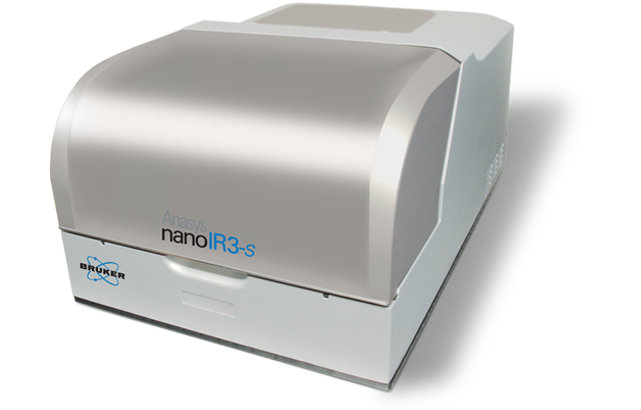Anasys nanoIR3-s
布鲁克Anasys的 nanoIR3-s 系统将散射扫描近场光学显微镜(s-SNOM)、纳米级红外光谱(AFM-IR)与原子力显微镜(AFM)完美整合到单一平台。依托 Anasys 技术在 AFM 纳米光学表征方面的领先地位,nanoIR3-s 可提供纳米级红外光谱、化学成像和光学成像,在 2D 材料样品上实现 10 纳米空间分辨率。该系统还可以提供达到纳米级分辨率的 AFM 形貌和性能成像,因此是对各种材料科学应用开展相关性研究的理想仪器。
To learn more, continue reading, contact us, or see FAQs about this product.
10nm 空间分辨率化学成像和光谱
石墨烯等离子体
高分辨性能成像
高性能纳米级 FTIR 光谱
| 只有 nanoIR3-s 能够提供: |
|
|
|
|
点光谱技术
POINTspectra 激光器可执行多个波长的光谱分析和高分辨光学成像。nanoIR3-s让测试更加简单:
- 在 AFM 图像中选择要测量的特征
- 测量样品的波谱,选择感兴趣的波长
- 采集高分辨光学属性图
Broadband Laser Option
Nanoscale FTIR spectroscopy with the broadest available spectral range (670 to 4000 cm⁻¹)
Equipped with optional OPO/DFG femtosecond laser technology, the nanoIR3-s system delivers the broadest spectral range to enable high-performance combined spectroscopy and high-resolution nanochemical imaging. This unique set of capabilities enables research in a broad range of research areas in historically inaccessible spectral regions.
Complementary high-resolution imaging
High-quality, high-resolution nano-optical images can be generated for characterization of a wide range of optical phenomena, such as graphene plamonics and surface phonon polaritons in hexagonal boron nitride (hBN), and chemical imaging of biological and other organic samples.
Frequently Asked Questions
Yes, nanoIR3-s combines AFM-IR with s-SNOM capabilities for advanced studies of plasmonic, photonic, and electronic materials. Offering multimodal nanospectral analysis.
nanoIR3-s offers Tapping AFM-IR and Resonance Enhanced AFM-IR as standard, and can be equipped with Surface Sensitive AFM-IR if the appropriate lasers and probes are included in the configuration.
External-source coupling is possible but should be discussed with Bruker to ensure compatibility.
More About Bruker's Nanoscale Infrared Technology
Yes. Bruker’s photothermal AFM-IR technology produces spectra that are directly comparable to FTIR spectra, as demonstrated in published documentation and peer-reviewed articles. AFM-IR spectra can be searched directly against FTIR spectral databases. If FTIR-like spectral analysis is critical for your application, our experts can provide evidence showing spectral correlation.
Photothermal AFM-IR provides direct absorption-based spectra that closely match FTIR results and are easier to interpret than Raman-AFM or s-SNOM. Further, Photothermal AFM-IR signals are amplified by the resonant enhancement of the cantilever providing the best signal-to-noise of those techniques. Bruker offers s-SNOM as a separate option for advanced near-field studies.
Bruker nanoIR systems routinely achieve chemical imaging with spatial resolution below 10 nm and can detect single molecular layers. Actual performance depends on your sample and selected measurement mode.
Yes, photothermal AFM-IR can chemically map and identify particles smaller than one micron, including nanoplastics and environmental contaminants. Direct correlation to FTIR provides ready interpretation in particles as small as 10 nm.
Bruker’s photothermal AFM-IR systems typically require a single socket of standard electrical power,and CDA. Specific requirements may vary by model, so request a site preparation guide from your Bruker representative.
Bruker photothermal AFM-IR systems primarily use quantum cascade lasers (QCLs) that deliver stable, reliable performance and broad coverage across the mid-infrared fingerprint region as well as optical parametric oscillators (OPOs) for the C-H, O-H, N-H stretching region. Multiple QCL chips can be combined to access all key spectral windows required for routine and advanced research, and additional sources are available for specialized applications. Bruker’s application experts can help you select the optimal laser configuration to match your measurement needs and ensure sufficient spectral resolution for both standard and demanding experiments.
Measurement times vary by application, but point spectra can be acquired in seconds, chemical maps in minutes, and automated recipes can be tailored for high-throughput workflows.
Routine maintenance includes probe replacement, laser alignment checks, and calibration with reference samples. Bruker provides detailed maintenance protocols and support plans.
